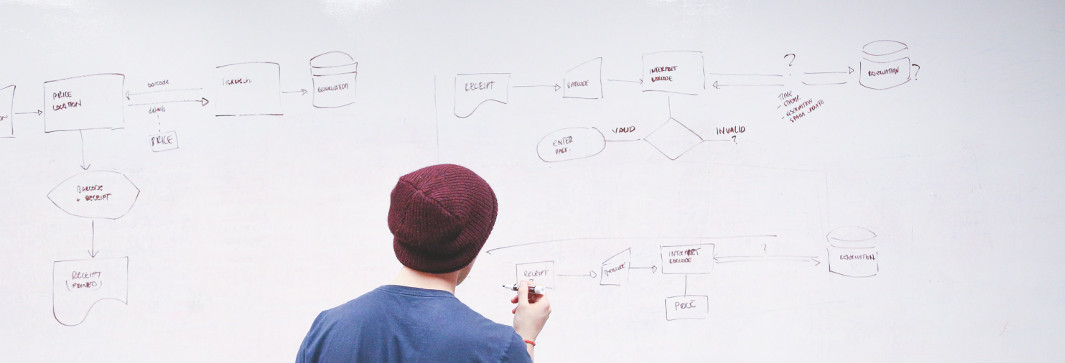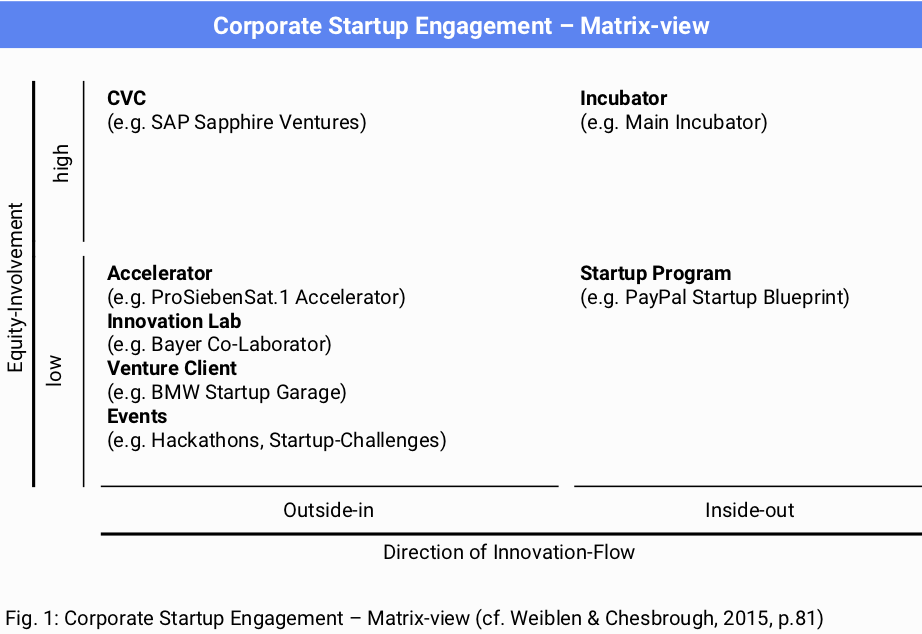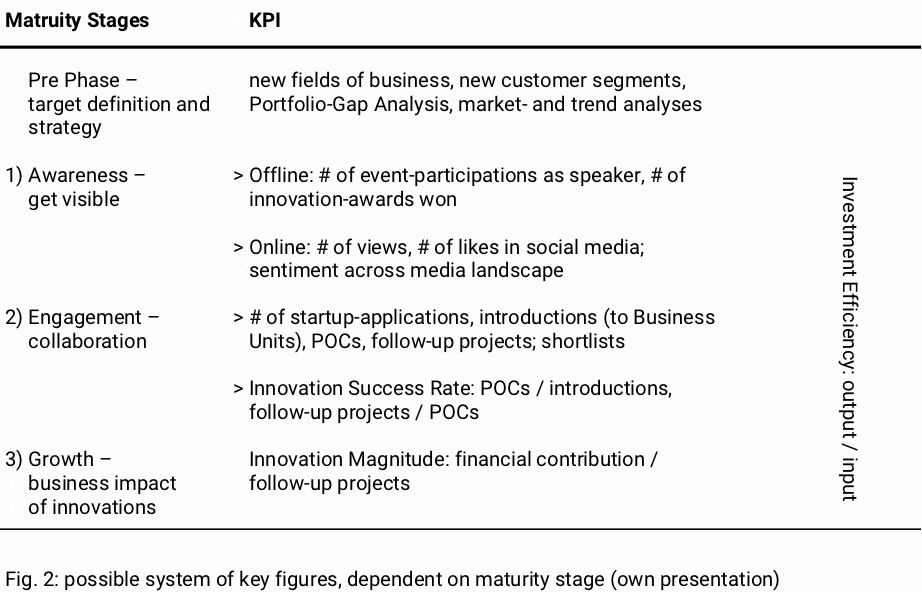Bitkom Membership
July 29, 2019
Innovate or Die
November 27, 2019An Analysis on how current Innovation Measures can be adapted to Corporate Startup Engagement
Nowadays Corporates are more and more challenged by upcoming, disruptive Startups with new digital business models. As a result we see increasing attention being paid to startup collaborations, in order to get innovation fast and cost-effective. Studies that are focussing on success factors for this kind of innovation vehicles oftentimes point out the necessity of Key Performance Indicators to measure the success of these open innovation initiatives.

What are we talking about when the term “Corporate Startup Engagement” comes up?
Scientifically speaking, startup collaborations can be classified in a matrix like this.
The corporate activities can be separated along the two axis innovation flow and equity orientation. A corporate venture capital unit would normally take a higher share, whereas a venture client's primary objective is the generation of minimum viable products. In Incubators, in an original sense, ideas are primarily generated inside the company whilst Accelerators create them with startups.
In fact, there are no such strict boundaries in between the vehicles. It seems that corporates design their activities along their needs and model them, based on their interpretation of open innovation. In the beginning they were oriented towards private Accelerators, like the Y-Combinator. In the meantime a change towards providing their own core competency and the idea of not to harm the startups by taking too much equity up front can be identified. Simply put, considering the matrix, there is a development towards the lower corner on the left – with the similarity between corporates that, with their startup collaborations, they want to create proof of concepts for their business units.
In fact, there are no such strict boundaries in between the vehicles. It seems that corporates design their activities along their needs and model them, based on their interpretation of open innovation. In the beginning they were oriented towards private Accelerators, like the Y-Combinator. In the meantime a change towards providing their own core competency and the idea of not to harm the startups by taking too much equity up front can be identified. Simply put, considering the matrix, there is a development towards the lower corner on the left – with the similarity between corporates that, with their startup collaborations, they want to create proof of concepts for their business units.
Possible KPI for measuring the success of this type of startup collaborations
In studies, for example of consulting firms, benefits, challenges and success factors of startup corporations can already be pointed out quite well. In this context KPI are oftentimes mentioned as one success factor – usually without being analysed more in detail. In times of crisis however, innovation units like this turn out to not being very resilient to crisis – innovation would fall victim to austerity measures.Hence, the aim is to make the success of innovation units visible – so how can it be measured?
It can be helpful to sort the maturity of corporate startup activities in different stages, which allows to identify KPI suitable for every phase. Comparing different approaches to measuring innovation to the operational practice of innovation units, the following key figures may result.

The development of a startup collaboration entity, from launch to business impact, is basically grouped in three phases. Here another, strategic, first phase is added.
Pre Phase
This phase would especially target one frequently mentioned success factor for Innovation Hubs and other vehicles – a clear target as well as an alignment of strategy and innovation ambitions. To clarify in advance if new business areas or customer segments shall be explored through the engagement-activities it helps to effectively steer the unit later on. This might also be helpful during the design process of the program, in regard to having an unique selling proposition and providing added value to the startups from the very start.Awareness Phase
Usually this phase comes first and its problem is that new innovation units begin with communicating a corporation with startups just to be seen as an innovative company from now on. But in fact there is a lack of internal structures at this time, which means that providing real results is not possible then. The KPI displayed for this phase can be used to control marketing budgets, save them from being wasted and to make sure to reach the second phase faster, which is distinguished by having real collaboration in the form of joint POCs.Engagement Phase
In this phase it can be helpful to document and count at first: for example the number of startups which have been introduced to the business units. Other than that, it can be useful to apply an Innovation Success Rate (Anthony, 2013). The number of generated POCs divided by the number of startups introduced to the Business Units for example is a good measure to identify the effort the Innovation Unit has put into this open innovation initiative. Depending on the structure of the program this ratio can be designed differently. The importance lies in considering to measure real impact. Dividing the number of signed non-disclosure agreements by the number of startups of a shortlist (a closer selection of suitable startups) for example would generate a ratio which motivates the Innovation Unit to sign lots of NDAs – although they are not providing any value, compared to POCs, and therefore are not suitable to give indication of the programs success.Growth Phase
The main goal for startup vehicles is to bring innovations into the business and generate impact in form of sales contributions. A conceivable solution would be to create an Innovation Magnitude (Anthony, 2013). Sales contributions of projects finally transfered to the Business Unit would be a possible measure. But depending on the level of consideration, it's difficult to filter out the startups contribution to that. Products make it easier to trace these streams than technologies. Bottom line, it may be useful to measure the success of a startup vehicle in the second phase, since follow-up projects are oftentimes realized directly in the business unit. Sales contributions generated then are hard to trace back to the startup program, and even if possible, this kind of ROI comes too late.By the implementation of an input/output ratio, additional control can be reached in the form of an Investment Efficiency (Anthony, 2013), which applies to all three phases. If one wants to show the input transparently, this can include salaries of the (Junior-) Innovation Management, infrastructure costs for premises and IT, travel expenses, budget (e.g. for marketing), legal costs for contracts as well as executives salaries on a proportionate basis.
However, this is not being measured currently. A possible reason for that might be that it is quite difficult to quantify the output, without having a bad impression of the innovations-unit success in comparison to the input. For example: creativity, agile methods or Know-how are regarded as important outputs and learnings of a startup cooperation. Know-how under certain circumstances might be quantified in the form of patents, but for the rest momentarily there is a lack of approaches. A topic which requires further research – especially when considering that the needs of the innovation units concerning input measurement seem to be inconsistent. Some of them are promoted by the public sector and hence are not dependent on success metrics, or they are regarded as internal service providers whose costs are accepted at first. However, other units have been abolished.
However, this is not being measured currently. A possible reason for that might be that it is quite difficult to quantify the output, without having a bad impression of the innovations-unit success in comparison to the input. For example: creativity, agile methods or Know-how are regarded as important outputs and learnings of a startup cooperation. Know-how under certain circumstances might be quantified in the form of patents, but for the rest momentarily there is a lack of approaches. A topic which requires further research – especially when considering that the needs of the innovation units concerning input measurement seem to be inconsistent. Some of them are promoted by the public sector and hence are not dependent on success metrics, or they are regarded as internal service providers whose costs are accepted at first. However, other units have been abolished.
Key Learnings
Taking into account that most of the units can be assigned to the second phase, KPIs enable a higher transparency, a sustainable budget management as well as the possibility to continuously steer the program along its strategic target. Attention has to be paid to a clear coordination with all relevant stakeholders, when implementing such measures. Upper management representatives, as well as all other recipients have to be trained on what the metrics say and how they can be interpreted. Otherwise there can be misunderstandings – a false interpretation of the results might end up in a bad mood towards the innovation unit.Insights based on descriptive study of literature, in depth interviews with startup program executives of German corporates, as well as university researcher in the field of measuring innovation.
Other sources:
* Anthony, S. D. (2013). How To Really Measure a Company's Innovation Prowess. Harvard Business Review.
** Weiblen, T., & Chesbrough, H. W. (2015). Engaging with startups to enhance corporate innovation. California Management Review, 57(2), 66–90.
* Anthony, S. D. (2013). How To Really Measure a Company's Innovation Prowess. Harvard Business Review.
** Weiblen, T., & Chesbrough, H. W. (2015). Engaging with startups to enhance corporate innovation. California Management Review, 57(2), 66–90.




